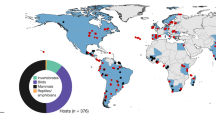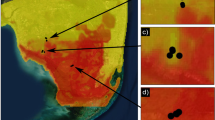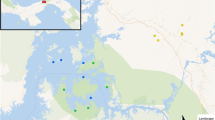Abstract
Anthropogenic environmental change can impact community and population traits such as species diversity and population densities, which have been shown to influence the prevalence of viruses in wildlife reservoirs. In particular, host species resilient to changes in their natural habitat may increase in numbers, which in turn can affect the prevalence of directly transmitted viruses. We have carried out a survey of small mammal communities in three tropical landscapes differing in their degree of environmental change in Central Panama and investigated the effects of community changes on Hepacivirus prevalence. The modification of continuous habitat into partly connected or isolated habitat patches during the past century was linked to changes in species diversity and species assemblages, which was further associated with shifts in the abundance of generalist marsupial (Didelphis marsupialis, Philander opossum) and rodent (Proechimys semispinosus) species. The latter has become dominant in isolated habitat patches and was the only identified Hepacivirus host in our study system. Our analyses suggest that, in addition to the effects of host age and sex, host population density in interaction with sex ratio is a crucial predictor of infection probability. Although we found no significant relationships between species diversity per se and infection probability, the lowest prevalence detected in the landscape with the highest species diversity indicates that shifts in species assemblages (e.g. changes in the presence and abundance of marsupial predators) impact the host’s intraspecific contact rates, the probability of virus transmission and, thus, the virus prevalence. Our study additionally provides important data on the influence of human-induced landscape changes on infection probability and, therefore, on virus prevalence in wildlife and emphasizes the importance of a landscape-scale approach with concomitant consideration of the complex interactions between ecological factors.



Similar content being viewed by others
References
Adler GH (1994) Tropical forest fragmentation and isolation promote asynchrony among populations of a frugivorous rodent. J Anim Ecol 63:903–911
Adler GH, Levins R (1994) The island syndrome in rodent populations. Q Rev Biol 69:473–482
Adler GH, Endries M, Piotter S (1997) Spacing patterns within populations of a tropical forest rodent, Proechimys semispinosus, on five Panamanian islands. J Zool 241:43–53
Aguilar JR, Westerdahl H, la Puente JM, Tomás G, Martínez J, Merino S (2016) MHC-I provides both quantitative resistance and susceptibility to blood parasites in blue tits in the wild. Philos Trans R Soc Lond B Biol Sci 47:669–677
Ahumada JA, Silva CEF, Gajapersad K, Hallam C, Hurtado J, Martin E, McWilliam A, Mugerwa B, O’Brien T, Rovero F, Sheil D, Spironello WR, Winarni N, Andelman SJ (2011) Community structure and diversity of tropical forest mammals: data from a global camera trap network. Philosophical Transactions of the Royal Society B: Biological Sciences 366:2703–2711
Anggakusuma, Brown RJP, Banda DH, Todt D, Vieyres G, Steinmann E, Pietschmann T (2016) Hepacivirus NS3/4A proteases interfere with MAVS signaling in both their cognate animal hosts and humans: implications for zoonotic transmission. J Virol 90:10670–10681
Arias-Del Razo I, Hernández L, Laundré JW, Velasco-Vázquez L (2012) The landscape of fear: habitat use by a predator (Canis latrans) and its main prey (Lepus californicus and Sylvilagus audubonii). Can J Zool 90:683–693
Bachman GC (1993) The effect of body condition on the trade-off between vigilance and foraging in Belding’s ground squirrels. Anim Behav 46:233–244
Bernshtein AD, Apekina NS, Mikahailova TV, Myasnikov YuA, Khlyap LA, Korotkov YuS, Gavrilovskaya IN (1999) Dynamics of Puumala hantavirus infection in naturally infected bank voles (Clethrinomys glareolus). Adv Virol 144:2415–2428
Bordes F, Morand S, Pilosof S, Claude J, Krasnov BR, Cosson JF, Chaval Y, Ribas A, Chaisiri K, Blasdell K, Herbreteau V, Dupuy S, Tran A (2015) Habitat fragmentation alters the properties of a host-parasite network: rodents and their helminths in South-East Asia. J Anim Ecol 84:1253–1263
Borremans B, Leirs H, Gryseels S, Günther S, Makundi R, de Bellocq JG (2011) Presence of Mopeia Virus, an African arenavirus, related to biotope and individual rodent host characteristics: implications for virus transmission. Vector Borne Zoonotic Dis 11:1125–1135
Brearley G, Rhodes J, Bradley A, Baxter G, Seabrook L, Lunney D, Liu Y, McAlpine C (2013) Wildlife disease prevalence in human-modified landscapes. Biol Rev 88:427–442
Burnham K, Anderson D (2002) Model selection and multi-model inference—a practical information-theoretic approach. Springer, New York
Civitello DJ, Cohen J, Fatima H, Halstead NT, Liriano J, McMahon TA, Ortega CN, Sauer EL, Sehgal T, Young S, Rohr JR (2015) Biodiversity inhibits parasites: broad evidence for the dilution effect. Proc Natl Acad Sci 112:8667–8671
Colizza V, Vespignani A (2007) Invasion threshold in heterogeneous metapopulation networks. Phys Rev Lett 99:148701
Colwell RK (2013) EstimateS: statistical estimation of species richness and shared species from samples. Version 9. User’s Guide and application published at: http://purl.oclc.org/estimates
Condit R, Robinson WD, Ibáñez R, Aguilar S, Sanjur A, Martínez R, Stallard RF, García T, Angehr GR, Petit L, Wright SJ, Robinson TR, Heckadon S (2001) The status of the Panama Canal watershed and its biodiversity at the beginning of the 21st century. Long-term ecological studies reveal a diverse flora and fauna near the Panama Canal, harbored within a corridor of forest stretching from the Caribbean to the Pacific, but deforestation, land degradation, erosion, and overhunting remain threats. Bioscience 51:389–398
Corman VM, Grundhoff A, Baechlein C, Fischer N, Gmyl A, Wollny R, Dei D, Ritz D, Binger T, Adankwah E, Marfo KS, Annison L, Annan A, Adu-Sarkodie Y, Oppong S, Becher P, Drosten C, Drexler JF (2015) Highly divergent hepaciviruses from African cattle. J Virol 89:5876–5882
Cross PC, Lloyd-Smith JO, Johnson PLF, Getz WM (2005) Duelling timescales of host movement and disease recovery determine invasion of disease in structured populations. Ecol Lett 8:587–595
Cruz-Salazar B, Ruiz-Montoya L, Vázquez-Domínguez E, Navarrete-Gutiérrez D, Espinoza-Medinilla EE, Vázquez L-B (2016) Genetic diversity of Didelphis virginiana related to different levels of disturbance in the Highlands and the Central Depression regions of Chiapas, Mexico. J Trop Ecol 32:146–157
D’Amico M, Clevenger AP, Román J, Revilla E (2015) General versus specific surveys: estimating the suitability of different road-crossing structures for small mammals. J Wildl Manag 79:854–860
Dale VH, Brown S, Calderón MO, Montoya AS, Martínez RE (2003) Estimating baseline carbon emissions for the eastern Panama Canal watershed. Mitig Adapt Strat Glob Change 8:323–348
Drexler JF, Corman VM, Müller MA, Lukashev AN, Gmyl A, Coutard B, Adam A, Ritz D, Leijten LM, van Riel D, Kallies R, Klose SM, Gloza-Rausch F, Binger T, Annan A, Adu-Sarkodie Y, Oppong S, Bourgarel M, Rupp D, Hoffmann B, Schlegel M, Kümmerer BM, Krüger DH, Schmidt-Chanasit J, Setién AA, Cottontail VM, Hemachudha T, Wacharapluesadee S, Osterrieder K, Bartenschlager R, Matthee S, Beer M, Kuiken T, Reusken C, Leroy EM, Ulrich RG, Drosten C (2013) Evidence for novel hepaciviruses in rodents. PLoS Pathog 9:e1003438
Drosten C, Günther S, Preiser W, van der Werf S, Brodt H-R, Becker S, Rabenau H, Panning M, Kolesnikova L, Fouchier RAM, Berger A, Burguière A-M, Cinatl J, Eickmann M, Escriou N, Grywna K, Kramme S, Manuguerra J-C, Müller S, Rickerts V, Stürmer M, Vieth S, Klenk H-D, Osterhaus ADME, Schmitz H, Doerr HW (2003) Identification of a novel coronavirus in patients with severe acute respiratory syndrome. N Engl J Med 348:1967–1976
Ecke F, Angeler DG, Magnusson M, Khalil H, Hörnfeldt B (2017) Dampening of population cycles in voles affects small mammal community structure, decreases diversity, and increases prevalence of a zoonotic disease. Ecol Evol 7:5331–5342
Efford MG (2015) Secr: Spatially explicit capture-recapture models. R package version 2.9
Ellis EC, Klein Goldewijk K, Siebert S, Lightman D, Ramankutty N (2010) Anthropogenic transformation of the biomes, 1700–2000: anthropogenic transformation of the biomes. Glob Ecol Biogeogr 19:589–606
Firth C, Bhat M, Firth MA, Williams SH, Frye MJ, Simmonds P, Conte JM, Ng J, Garcia J, Bhuva NP, Lee B, Che X, Quan P-L, Lipkin WI (2014) Detection of zoonotic pathogens and characterization of novel viruses carried by commensal Rattus norvegicus in New York City. mBio 5:e01933
Fleming TH (1971) Population ecology of three species of neotropical rodents. Misc Publ Mus Zool Univ Mich 143:1–77
Foo YZ, Nakagawa S, Rhodes G, Simmons LW (2017) The effects of sex hormones on immune function: a meta-analysis. Biol Rev Camb Philos Soc 92:551–571
Gotelli NJ, Colwell RK (2001) Quantifying biodiversity: procedures and pitfalls in the measurement and comparison of species richness. Ecol Lett 4:379–391
Hollings TM, Jones N, Mooney N, McCallum H (2015) Disease-induced decline of an apex predator drives invasive dominated states and threatens biodiversity. Ecology 97:394–405
Huang ZYX, van Langevelde F, Prins HHT, de Boer WF (2015) Dilution versus facilitation: impact of connectivity on disease risk in metapopulations. J Theor Biol 376:66–73
Jones KE, Patel NG, Levy MA, Storeygard A, Balk D, Gittleman JL, Daszak P (2008) Global trends in emerging infectious diseases. Nature 451:990–993
Kamil B (2016) MuMIn: multi-model inference. R package version 1.15.6. 1.15.6
Kapoor A, Simmonds P, Scheel TKH, Hjelle B, Cullen JM, Burbelo PD, Chauhan LV, Duraisamy R, Sanchez Leon M, Jain K, Vandegrift KJ, Calisher CH, Rice CM, Lipkin WI (2013) Identification of rodent homologs of hepatitis C virus and pegiviruses. mBio 4:e00216
Kats LB, Dill LM (1998) The scent of death: chemosensory assessment of predation risk by prey animals. Écoscience 5:361–394
Kats LB, Dill LM (2016) The scent of death: chemosensory assessment of predation by prey animals. Écoscience 5:361–394
Keesing F, Holt RD, Ostfeld RS (2006) Effects of species diversity on disease risk. Ecol Lett 9:485–498
Kuijper DPJ, de Kleine C, Churski M, van Hooft P, Bubnicki J, Jędrzejewska B (2013) Landscape of fear in Europe: wolves affect spatial patterns of ungulate browsing in Białowieża Primeval Forest, Poland. Ecography 36:1263–1275
Lechner AM, Sprod D, Carter O, Lefroy EC (2017) Characterising landscape connectivity for conservation planning using a dispersal guild approach. Landsc Ecol 32:99–113
LoGiudice K, Ostfeld RS, Schmidt KA, Keesing F (2003) The ecology of infectious disease: effects of host diversity and community composition on Lyme disease risk. Proc Natl Acad Sci 100:567–571
Lüdecke, D. 2017. sjPlot: Data visualization for statistics in social science. R package version 2.4.0, https://CRAN.R-project.org/package=sjPlot
Maliniak E, Eisenberg JF (1971) Breeding spiny rats in captivity. Int Zoo Yearb 11:93–98
Mariën J, Borremans B, Gryseels S, Vanden Broecke B, Becker-Ziaja B, Makundi R, Massawe A, Reijniers J, Leirs H (2017) Arenavirus dynamics in experimentally and naturally infected rodents. EcoHealth 14:463–473
Mills JN, Childs JE (1998) Ecologic studies of rodent reservoirs: their relevance for human health. Emerg Infect Dis 4:529–537
Murone J, DeMarchi JA, Venesky MD (2016) Exposure to corticosterone affects host resistance, but not tolerance, to an emerging fungal pathogen. PLoS One 11:e0163736
Murray KA, Daszak P (2013) Human ecology in pathogenic landscapes: two hypotheses on how land use change drives viral emergence. Curr Opin Virol 3:79–83
Ostfeld RS, Holt RD (2004) Are predators good for your health? Evaluating evidence for top-down regulation of zoonotic disease reservoirs. Front Ecol Environ 2:13–20
Ostfeld RS, Keesing F (2000) Biodiversity series: the function of biodiversity in the ecology of vector-borne zoonotic diseases. Can J Zool 78:2061–2078
Ostfeld RS, Keesing F (2012) Effects of host diversity on infectious disease. Annu Rev Ecol Evol Syst 43:157–182
Owen JC, Nakamura A, Coon CA, Martin LB (2012) The effect of exogenous corticosterone on West Nile virus infection in northern cardinals (Cardinalis cardinalis). Vet Res 43:34
Parker TS, Nilon CH (2008) Gray squirrel density, habitat suitability, and behavior in urban parks. Urban Ecosyst 11:243–255
Plowright RK, Field HE, Smith C, Divljan A, Palmer C, Tabor G, Daszak P, Foley JE (2008) Reproduction and nutritional stress are risk factors for Hendra virus infection in little red flying foxes (Pteropus scapulatus). Proc R Soc Lond B Biol Sci 275:861–869
Plowright RK, Eby P, Hudson PJ, Smith IL, Westcott D, Bryden WL, Middleton D, Reid PA, McFarlane RA, Martin G, Tabor GM, Skerratt LF, Anderson DL, Crameri G, Quammen D, Jordan D, Freeman P, Wang L-F, Epstein JH, Marsh GA, Kung NY, McCallum H (2014) Ecological dynamics of emerging bat virus spillover. Proc R Soc Lond B Biol Sci 282:20142124–20142125
Pybus OG, Thézé J (2016) Hepacivirus cross-species transmission and the origins of the hepatitis C virus. Curr Opin Virol 16:1–7
R Core Team (2017) R: a language and environment for statistical computing. R Foundation for Statistical Computing, Vienna
Randolph SE, Dobson ADM (2012) Pangloss revisited: a critique of the dilution effect and the biodiversity-buffers-disease paradigm. Parasitology 139:847–863
Rompré G, Robinson WD, Desrochers A (2008) Causes of habitat loss in a neotropical landscape: the Panama Canal corridor. Landsc Urban Plan 87:129–139
Scantlebury M, Maher McWilliams M, Marks NJ, Dick JTA, Edgar H, Lutermann H (2010) Effects of life-history traits on parasite load in grey squirrels. J Zool 282:246–255
Schad J, Ganzhorn JU, Sommer S (2005) Parasite burden and constitution of major histocompatibility complex in the Malagasy mouse lemur, Microcebus murinus. Evolution 59:439–450
Schmidt KA, Ostfeld RS (2001) Biodiversity and the dilution effect in disease ecology. Ecology 82:609–619
Schradin C, Schneider C, Lindholm AK (2010) The nasty neighbour in the striped mouse (Rhabdomys pumilio) steals paternity and elicits aggression. Front Zool 7:19
Sol D, Jovani R, Torres J (2003) Parasite mediated mortality and host immune response explain age-related differences in blood parasitism in birds. Oecologia 135:542–547
Sozio G, Mortelliti A (2016) Empirical evaluation of the strength of interspecific competition in shaping small mammal communities in fragmented landscapes. Landscape Ecol 31:775–789
Steinmann AR, Priotto JW (2010) Inter-male aggression in relation to female availability and residence status in corn mice Calomys musculinus. Acta Theriol 56:81–89
Suchomelova E, Frynta D, Suchomelova E, Frynta D (2000) Intraspecific behavioural interactions in Apodemus microps: a peaceful mouse? Acta Theriol 45:201–209
Suzán G, Marcé E, Giermakowski JT, Mills JN, Ceballos G, Ostfeld RS, Armién B, Pascale JM, Yates TL (2009) Experimental evidence for reduced rodent diversity causing increased hantavirus prevalence. PLoS One 4:e5461
Tanaka G, Urabe C, Aihara K (2014) Random and targeted interventions for epidemic control in metapopulation models. Sci Rep 4:5522
Tersago K, Verhagen R, Vapalahti O, Heyman P, Ducoffre G, Leirs H (2011) Hantavirus outbreak in western Europe: reservoir host infection dynamics related to human disease patterns. Epidemiol Infect 139:381–390
Tyndale-Biscoe H (2005) Life of marsupials. CSIRO Publishing, Collingwood
Verbrugghe E, Boyen F, Gaastra W, Bekhuis L, Leyman B, Van Parys A, Haesebrouck F, Pasmans F (2012) The complex interplay between stress and bacterial infections in animals. Vet Microbiol 155:115–127
Vogel G (2014) Are bats spreading Ebola across sub-Saharan Africa? Sierra 5:11–30
Woodroffe R, Prager KC, Munson L, Conrad PA, Dubovi EJ, Mazet JAK (2012) Contact with domestic dogs increases pathogen exposure in endangered African wild dogs (Lycaon pictus). PLoS One 7:e30099
Zuk M, McKean KA (1996) Sex differences in parasite infections: patterns and processes. Int J Parasitol 26:1009–1024
Zuur AF, Ieno EN, Elphick CS (2010) A protocol for data exploration to avoid common statistical problems. Methods Ecol Evol 1:3–14
Acknowledgements
We thank the Smithsonian Tropical Research Institute in Panamá for providing the essential infrastructure for our fieldwork. We are grateful to the private landowners and the company Argos for granting us access to their terrains and we extend our thanks to all field assistants. We also thank Stefan Brändel for taking care of the research permits and Theresa Jones for proofreading. We are grateful to Mark Gillingham for the guidance of our statistical analyses and to Nina Schwensow for discussion. We thank two anonymous reviewers for their thoughtful comments on the previous version of the manuscript. This research was funded by the German Science Foundation (DFG) and is part of the DFG Priority Program SPP 1596/2 Ecology and Species Barriers in Emerging Infectious Diseases (SO 428/9-1, 9-2 and DR 772/8-1).
Author information
Authors and Affiliations
Contributions
SS and CD conceived and designed the study. SS, JS, GE and RP coordinated field work and data collection. JS and GE conducted the field work. AR and VC designed the virus screening assay and coordinated the lab work. LJ performed the virus screening. JS analysed the data and wrote the first draft of the manuscript. All authors played a vital part in the preparation and revision of the manuscript.
Corresponding author
Additional information
Communicated by Herwig Leirs.
Electronic supplementary material
Below is the link to the electronic supplementary material.
Rights and permissions
About this article
Cite this article
Schmid, J., Rasche, A., Eibner, G. et al. Ecological drivers of Hepacivirus infection in a neotropical rodent inhabiting landscapes with various degrees of human environmental change. Oecologia 188, 289–302 (2018). https://doi.org/10.1007/s00442-018-4210-7
Received:
Accepted:
Published:
Issue Date:
DOI: https://doi.org/10.1007/s00442-018-4210-7




